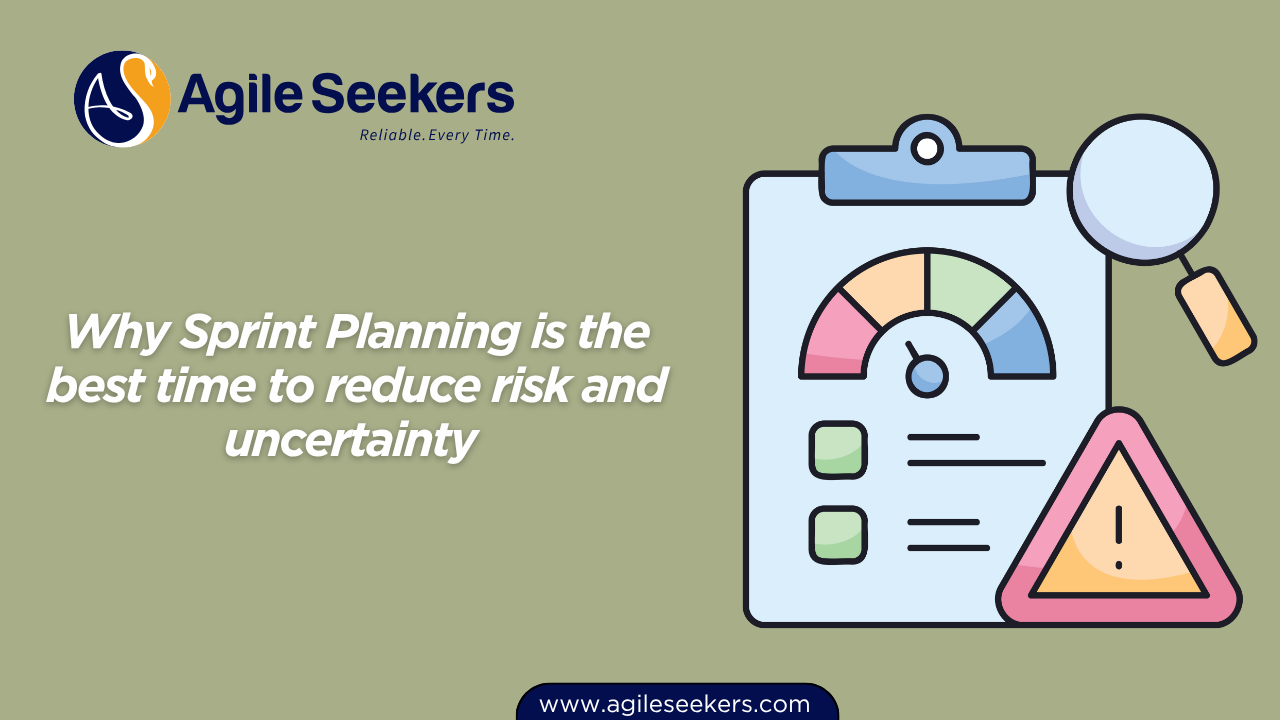Why Sprint Planning is the best time to reduce risk and uncertainty

Sprint Planning is often misunderstood as a simple meeting where teams pick work for the next iteration. What this session really does is bring clarity, alignment, and focus to the team.
More importantly, it reduces uncertainty long before work begins. When a team treats Sprint Planning as a strategic checkpoint, the entire Sprint becomes smoother and more predictable.
Hidden risks usually show up before the Sprint begins: unclear stories, missing acceptance criteria, incorrect assumptions, unvalidated priorities, technical dependencies, and unrealistic capacity expectations. Sprint Planning exposes these unknowns early, giving the team a chance to address them while there is still time to act.
Why Sprint Planning Works as a Risk-Reduction Tool
Three things happen naturally during Sprint Planning:
- The team gains clarity — which reduces misunderstanding risk.
- The team aligns on priorities — which reduces expectation and dependency risk.
- The team makes intentional choices — which reduces overload and incomplete work.
Leaders who go through structured programs like the Leading SAFe Agilist training often treat Sprint Planning as a strategic risk-management moment rather than a routine step.
1. Sprint Planning Exposes Ambiguities Early
Most backlog items hide uncertainty. When the team starts digging in Sprint Planning, vague stories immediately reveal assumptions, gaps, and missing details. Ambiguity is one of the biggest sources of rework and delays. Addressing it upfront saves time and stress.
Strong Product Owners — especially those trained through the SAFe POPM certification — know clarity is the most effective way to reduce risk.
2. Sprint Planning Helps Teams Challenge Assumptions
Assumptions like “this shouldn’t take long” or “the API will be ready” can quietly destroy a Sprint. Sprint Planning invites developers, testers, and the PO to challenge these assumptions before coding begins.
A skilled Scrum Master — supported by the foundation from the SAFe Scrum Master certification — ensures the team doesn’t let assumptions pass without healthy discussion.
3. Sprint Planning Surfaces Technical Dependencies
Dependencies are one of the most common ways Sprints derail. They usually involve architecture work, integration points, vendor support, test environments, or another team. Sprint Planning is where these dependencies become visible.
Professionals who complete the SAFe Advanced Scrum Master certification learn to identify system-level risks early, not just story-level ones.
4. It Makes Capacity Risk Real Instead of Assumed
Teams sometimes forget to consider leave plans, support load, production issues, or onboarding work. Sprint Planning forces the team to evaluate real capacity instead of guessing. This reduces the risk of unfinished work.
RTEs trained through the SAFe Release Train Engineer certification guide teams to make capacity transparent and predictable across multiple teams in the ART.
5. Sprint Planning Encourages Smaller, Safer Work Slices
Big stories hide big risks. Smaller slices allow faster feedback, better testing, and more predictable delivery. Sprint Planning is the best time to break work into manageable chunks so uncertainty stays low and flow stays stable.
6. It Helps the Team Acknowledge Uncertainty Instead of Hiding It
Saying “we don’t fully know this yet” is not a weakness — it’s smart risk management. Sprint Planning allows the team to call out uncertainty early and decide whether to use spikes, quick prototypes, or early validation to reduce it.
7. It Aligns Expectations Across Everyone
Misalignment is one of the most expensive forms of risk in Agile teams. Sprint Planning brings everyone onto the same page regarding goals, scope, constraints, and priorities.
A strong Scrum Master — again with knowledge enhanced through the SAFe Scrum Master certification — ensures alignment is tight and nothing slips through.
8. It Connects Priorities With Realistic Delivery
Teams don’t just pick the highest priority item; they evaluate whether it’s feasible and safe to take on this Sprint. Some work needs de-risking first. Others need a spike. Sprint Planning is where the team evaluates whether they are setting themselves up for success or stress.
9. It Creates a Shared Commitment Around Risk
The Sprint Goal is a risk filter. When the team agrees on a clear goal, they keep their focus sharp and stay away from distractions and unplanned work. This dramatically lowers execution risk and increases forecasting accuracy.
10. It Sets Up Transparency for the Entire Sprint
A well-planned Sprint increases predictability. It creates visibility into blockers, reduces last-minute surprises, and allows the team to detect issues early. A Sprint that starts with clarity usually ends with confidence.
Useful External Concepts That Support Risk Reduction
- Scrum Guide’s guidance on Sprint Planning and commitment
- Cynefin framework for navigating uncertainty
- Lean principles around reducing variability and limits on WIP
- Discovery and delivery risk concepts popularized by Marty Cagan
These external frameworks reinforce that predictability starts with intentional planning.
Final Thoughts
Sprint Planning is not just a meeting at the start of the iteration. It’s the moment where the team decides whether the Sprint will be calm and predictable or chaotic and stressful. Reducing risk early gives the team more space for creativity, quality, and flow.
Teams that use Sprint Planning intentionally experience fewer escalations, fewer mid-Sprint surprises, and stronger outcomes sprint after sprint.
Also read - How Distributed Teams Can Run Effective Sprint Planning Sessions
Also see - How to make Sprint Planning more outcome focused instead of task focused




















